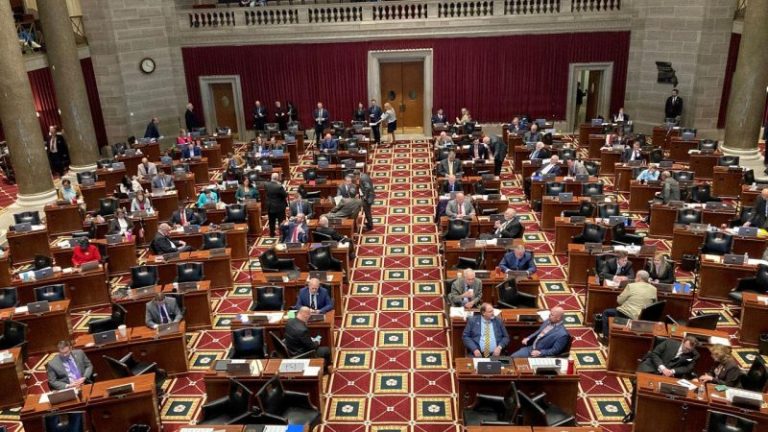Just six months after passing what was billed as the largest tax cut in Missouri history, the Republican-led state House voted Tuesday for an even bigger income tax cut that could return over $1 billion annually to individuals, corporations and retirees.
The Missouri legislation is the latest in a series of aggressive tax reductions that swept across U.S. states last year and have continued into 2023 — even as some warn that it might be wise for states to hold on to record large surpluses amid economic uncertainty.
‘Wouldn’t it be a good idea for us to all just pause for a year?’ Democratic state Rep. Deb Lavender asked rhetorically before her Republican colleagues endorsed the tax cut on a 109-45 party-line vote.
The Missouri legislation still has a ways to go — it needs a second House approval before it can move to the Senate and then to the governor. But legislatures and governors in several states already have given final approval to tax cuts and rebates in the first few months of this year. In some states, those tax breaks have been pushed by Republicans, but in others by Democrats.
South Dakota Gov. Kristi Noem, a Republican, signed legislation Tuesday that will lower the state’s sales tax for a four-year period, though she had originally wanted the GOP-led Legislature to eliminate the sales tax on groceries.
In Montana, Republican Gov. Greg Gianforte last week signed a $1 billion package of bills passed by the GOP-led Legislature that will provide both income and property tax rebates, reduce the top income tax rate and increase income tax credits for lower-income working families.
In Michigan, Democratic Gov. Gretchen Whitmer signed a bill passed by the Democratic-led Legislature that provides tax relief to retirees and to lower-income families.
And in West Virginia, Republican Gov. Jim Justice signed a measure passed by the GOP-led Legislature that reduces the income tax rate while also enlarging an income tax credit to offset personal property taxes paid on vehicles. The tax cut package is expected to return more than two-thirds of the state’s record $1.1 billion surplus to taxpayers, as opposed to spending it on state programs.
Nationwide, states’ total financial balances reached a record $343 billion at the end of their 2022 fiscal years — up 42% from the previous year, according to a recent report by The Pew Charitable Trusts.
Two-thirds of states approved some sort of tax relief last year, according to an analysis by The Associated Press.
Those surplus-induced tax breaks were enabled by stronger than expected state tax collections and an influx of federal pandemic aid both directly to states and to businesses and individuals that, in turn, injected more spending into the economy. But those federal payments are winding down, inflation remains persistently high and new challenges in the banking sector have raised questions about the overall economy.
‘This extraordinary chapter in state finances appears to be coming to an end,’ said Justin Theal, an officer with Pew’s State Fiscal Policy Project.
‘Tax cuts or new spending initiatives aren’t inherently bad or uncommon during good budgetary times,’ Theal said. But ‘if policymakers aren’t careful, these long-term commitments can place them in a more vulnerable fiscal position when the economy inevitably turns.’
In Missouri, some Republican lawmakers argued that more tax cuts ultimately would give residents more money to spend and lead to continued growth in state tax revenues.
Last October, Republican Gov. Mike Parson signed legislation cutting the top individual income tax rate from 5.3% to 4.95% effective Jan. 1 and allowing for an eventual reduction to 4.5% if revenues continue to grow. This year’s bill doesn’t wait to see whether that growth occurs. Instead, it would cut the individual income tax rate to 4.5% beginning in 2024 while also reducing taxes on corporations and Social Security benefits and enabling even more income tax cuts if future revenue targets are met.
‘This is not reckless. This is a meaningful step,’ Republican state Rep. Doug Richey said in response to critics. ‘This is simply slowing down the rate of growth for tax revenue.’
Other states also are following last year’s tax breaks with even more this year.
Kentucky Gov. Andy Beshear, a Democrat up for re-election this year, signed a plan passed by the Republican-led Legislature to cut the state’s individual income tax rate to 4% effective in 2024. That comes on the heels of a tax overhaul passed last year, which lowered the income tax rate from 5% to 4.5% in January.
In 2022, Republican Gov. Brian Kemp of Georgia suspended the state motor fuel tax for 10 months, and lawmakers approved a $1 billion income tax refund worth $250 to $500 for most tax filers. Earlier this month, Kemp signed an additional $1 billion income tax refund. He also signed a budget bill that includes nearly $1 billion for a property tax break.
Tax cut proposals are awaiting action elsewhere.
New Mexico’s Democratic-led Legislature recently passed a $1.1 billion tax relief package that includes $500 individual rebates, tax credits of up to $600 per child and a gradual reduction in taxes on sales and business services. Democratic Gov. Michelle Lujan Grisham has until April 7 to sign or veto bills.

